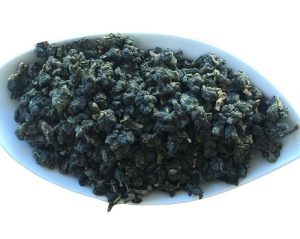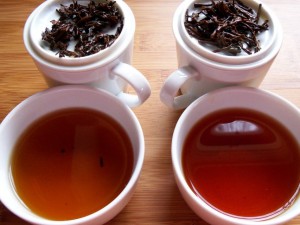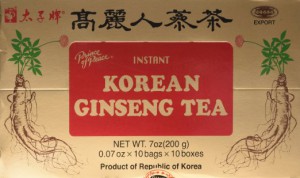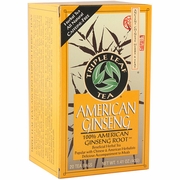Ginseng Oolong tea is primarily a fresh Oolong tea base with an added powder blended in to give it its unique aroma and taste profile. This tea is an easy drinking Oolong known for its pleasant taste, aroma and sweet, lingering aftertaste that can sometimes last for up to an hour or more after drinking it. Recognized as a good tea choice to drink after meals. The Ginseng Tea benefits are mostly comprised of the benefits associated with regular Oolong tea. Although it is called Ginseng Oolong tea it is 99.9% Oolong.
What Ginseng Oolong Tea is not
Ginseng Oolong tea is not Ginseng “tea” (Ginseng herbal infusion) which is made primarily from Ginseng root. This beverage is usually marketed as either American Ginseng Tea or Korean Ginseng Teas. Both origins are available and can be purchased at various stores including Amazon. Ginseng Oolong tea does not usually contain dried Ginseng root and if you are looking to benefit from the properties of Ginseng root, you are better off to go for an actual Ginseng root infusion and/or supplement. A good selection of Ginseng root products and supplements can be purchased HERE.
The Real Ingredient(s) in Ginseng Oolong Tea
There is a bit of controversy with Ginseng Oolong in regards to the ingredient(s) used in blending. Usually it is not powder from dried Ginseng root. So the name can tend to appear a bit deceptive to the uninformed if they are thinking they will benefit from the health attributes associated with Ginseng root when they drink this tea. Most Ginseng Oolong tea makers use Osmanthus, Liquorice, Yine Abrus or Jiaogulan as the blending powder. Each of these herbal ingredients are natural and do have significant health properties. They also enhance the taste of Ginseng Oolong. We have tested making Ginseng Oolong with real Ginseng root powder but the taste was too bitter and not suitable for an enjoyable, easy drinking tea. Our Ginseng Oolong teas are blended with natural Jiaogulan powder or the powder from naturally dried Yine Abrus leaves from Guangzhou region in China, which gives its unique pleasant tasting aroma and sweet, lingering after taste
How Ginseng Oolong Tea is Blended
There are two main blending methods for Ginseng Oolong tea. The tea was originally first blended in Taiwan. The Taiwanese tea makers make this tea by blending the powder inside the fresh leaves and rolling it in during the rolling process of the fresh leaves. By blending in the powder this way it ensures the full flavor and sweetness is there throughout the tea leaves uniformly and that it remains – even with multiple infusions. It was after the tea was introduced to mainland China in the 1980s that the tea blending process changed. At the time Ginseng Oolong was becoming in big demand in mainland China (and still is). The mainland Chinese, in an endeavor to imitate the Taiwan made Ginseng Oolong, covered the outside of the already rolled and processed

Ginseng Oolong – China blending method – The powder is blended in after tea leaf is rolled and processed

Ginseng Oolong – Taiwan blending method. The powder blended into the leaf before the rolling process.
Oolong tea leaf with the powder. As a result the quality is not as refined and the powder easily “washes” off after the first steeping of the tea, making additional steepings weaker in taste and flavor. The difference in the blending techniques is noticeable in the appearance of the tea. The China blended method looks obviously coated with powder and the Taiwan blended method looks more like a regular fresh Oolong rolled leaf.
Which is the Right Tea I Should Buy?
As I have mentioned in some other tea articles, there are many different processing techniques, blending methods and ingredients used with the making of teas – even those being marketed under the same tea name. It is not that one tea making technique, or one blending method, or ingredient used is better or worse than than the other. Everyone is to welcome to enjoy whatever tea taste, blending methods and ingredients they prefer with their tea. In other words if someone enjoys a Ginseng Oolong tea, like I do sometimes, and knows it is not real Ginseng root, that is totally fine. Enjoy!
I do feel however, it is important that people have the opportunity to make informed decisions and that they are not being deliberately misled by inaccurate product information.

3 piece Porcelain Tea Tasting Cup Sets – cup. lid and bowl (also includes a porcelain spoon for scooping up some tea for tasting) Tea quality is usually judged on color, aroma and taste of the tea plus the color and aroma of both the dry and infused leaf.
One other point worth mentioning here to those new to the world of tea, is that there are definite differences in tea quality. And, similar in some ways to wine tasting, you sometimes don’t realize how good a wine can taste until you have tasted a good wine. I have found the best way to taste and compare tea quality (or determine tasting preferences) is to make a brew of two or more different batches of the same tea variety using the exact same steeping time, water temperature and amount of tea. Then sip and compare. Of course it is a little difficult to do so when buying new teas online and it can sometimes be a bit of hit and miss until you find a good, reliable source of supply. But it is all a part of the tea journey. What has been your experience with finding and discovering the right tea(s) for your palate?





Ahh now this is one both me and my partner have tried out (I just read your gaba tea article!). Ginseng root has been noted for its many purported health benefits for years and years now and this kind of tea always has a unique kind of taste. At first I was not a fan but after having my arm twisted many times I finally got used to it. Great article!
Thanks for your comment Chris. Yes, Ginseng root definitely has an “acquired taste” but it is amazing what your body can get used to and even get to enjoy after it “adjusts”.
Hi Peter
This is a really informative article.
I have never heard of Ginseng Oolong Tea, but your description makes me really want to try it.
I was fascinated to read how the tea is made, and your images really add to the description.
I am a great tea drinker, and I would love to add this one to my repertoire! Do you know if it is also sold by Amazon UK?
I really enjoyed this article, very many thanks:)
Thanks for your comment Chrissie. Yes, it is a very pleasant tasting tea and gaining in popularity as people become more aware of it. Unfortunately it not being sold yet by Amazon UK as far as I know. My company is presently selling Ginseng Oolong on our Amazon Store in the US and we are planning to launch some of our teas- including Ginseng Oolong on Amazon UK shortly.
I am a major tea enthusiast and have added your website to my Must Reads. I drifted through many of your pages / posts and will return. I especially appreciate the information you provide your readers on Ginseng teas. Very helpful.
I will be making visits to your affiliate links as I am trying to build my collection of teas, tea cookware, and reading materials.
A big thank you for the guidance you give us on taste testing. Your website is a keeper.
Keep up the good work.
Thank you Loretta for your comments. Glad to hear you are finding the information helpful. Learning and discovering more about the world of tea certainly is fascinating and a great experience.